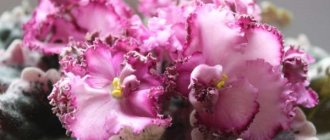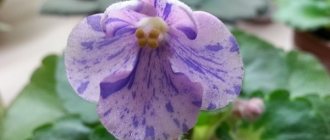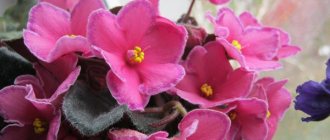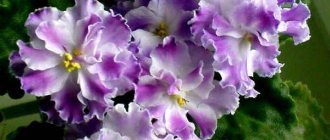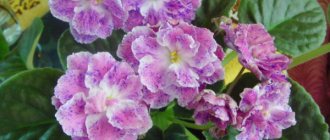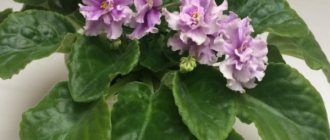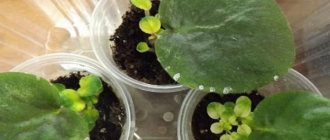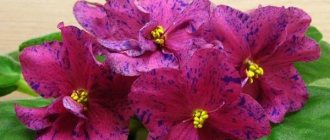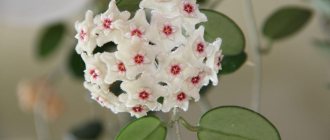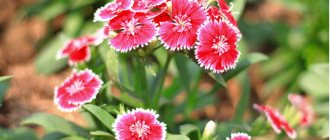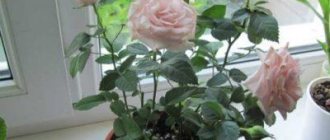At Saintpaulia exhibitions and photographs of violet breeders, the rosettes look like :
- Perfectly smooth;
- Symmetrical;
- And they amaze with their abundant cap blooms.
is it not always possible to achieve such a result at home ?
Compliance with the rules of agricultural technology when growing the variety, knowledge of the distinctive preferences of the Uzambara violet variety RM-Pavlina
will allow you to obtain:
- Excellent result;
- And the opportunity to show off a beautiful rosette with abundant flowering!
Introduction
Violets are incredibly delicate flowers that have become real favorites of modern gardeners. They fit perfectly into the interior of a room and are able to decorate absolutely any room, no matter where the gardener plants them or displays containers with indoor Saintpaulias. Considering the demand for this plant, breeders also tried very hard to bring out the maximum number of incredibly interesting plants, varied in shape and color, that would be loved by everyone and could satisfy the needs and tastes of any modern gardener. This is how a variety of violet appeared called Peacock violet (RM-Pavlina) - this is an amazing and incredibly beautiful flower, which is characterized by expressive, abundant and very bright flowering. At the same time, the abundance of flowers and their brightness are perfectly combined with the tenderness and sensuality of the flower, with its elegance. Due to this, Saintpaulia looks great both as part of a single planting and as part of a group planting, which very often decorates window sills and balconies, office premises and, in general, any premises.
Contents in room culture
classical care is enough for comfortable well-being :
- On northern window sills, violet requires lighting, on southern windowsills - shading;
- It is better to water in doses, drying the upper part of the substrate;
- Fertilize when necessary;
- Lighting is shown natural, diffused spectrum, for as long a period as possible;
- Maintain the temperature within optimal limits: +20 + 24°C;
This Saintpaulia requires standard care. - Humidity should be increased, any methods should be used, but the violet itself should not be sprayed;
- The substrate is rich in nutrition, aerated, with sufficient water permeability; drainage is required.
- When transplanting, it is better to resort to gentle transshipment.
Violet RM Pavlina: Description of the variety
Violet Peacock: photo
The versatility of violets is another characteristic due to which violets are so in demand and loved by gardeners today. The flower of this particular variety of Peacock violet stands out against the background of many other varieties and varieties. In this article we will tell you in more detail why this is so, what are the features and characteristic features of this planting, and why it stands out so favorably among all other violets, which, at the same time, in terms of prevalence and popularity, could sometimes surpass Peacock. Also in the article we will touch on the features of growing this variety of Peacock, what are the characteristic features of agricultural technology, and how this plant manifests itself in a variety of conditions.
On the bush of the Peacock violet variety of indoor Saintpaulia, very large buds appear, which then bloom as incredibly attractive flowers. The center of the flower is painted white, and most of the petal is painted in very bright and unique, fancy shades. It can be blue or pink shades, as well as purple. In a combination of several shades, you can also notice how fancy patterns are formed on the petals, which look incredibly elegant and attractive, and they really attract the attention of gardeners or their guests. The texture of the flower is semi-double; many experienced flower growers and specialists also note that the saturation of the shades very often depends on the temperature conditions in which the crop grows, and whether the same favorable microclimate has been created for it, which has a positive effect on growth and development and, accordingly, on the decorativeness of culture. As we can understand, all these conditions and circumstances are created by the hands of the grower himself, so the state of the planting, its external characteristics and the ability to display excellent quality flowers will depend on him.
Violet Peacock: photo
The leaves of the Peacock violet are colored in the standard green color. If all the necessary conditions have been created for the plant, then it will certainly grow and develop correctly. Accordingly, a small homogeneous, uniform rosette is formed, which will become the center of growth and development of the planting. The shape of the leaves is oblong, slightly rounded, so they look very organic and gentle in combination with the flowers. The very first flowers may appear approximately nine months after the plant was planted in a container for further development, but this will only happen if the grower initially followed all the rules of agricultural technology and did everything possible to make the plant feel comfortable. If the care is correct, you will be able to observe very lush and attractive flowering, and due to the fact that the color of the plant is very original, this variety and these violets stand out against the background of many other varieties and varieties of Saintpaulias.
From an official point of view, this variety of Peacock violet, like many other indoor violets, belongs to the genus of herbaceous plants, which are united under the name “Saintpaulia”. All representatives of this variety also have a common feature - their shades are always very beautiful and expressive, and this is what makes them stand out against the background of many other plantings and plants. Also, plants in general equally need certain agrotechnical rules, care, and compliance with similar points, if we talk specifically about such procedures. We will talk about this in the same article, because in many ways it has an impact on the growth and development of plantings.
RS-Reserved Forest
A little portrait. Growing on the shelf. We came to smile at the sun.
I really like the socket itself. It is absolutely not whimsical and forms itself. True, he refuses to take stepson, and for the better in my opinion. I can’t say that I’m completely delighted with the flowers. This one is even brighter, but her sister lives only because of the socket.
My sister started blooming earlier. But somehow it’s not active, maybe that’s why I don’t really like it. Peduncles in an upright position.
I want to say about the size: I’m very glad that I didn’t risk putting them in one bowl. I like it better this way.
What a wonderful baby
What a wonderful baby
I like the trailer, it's
I like the trailer, it has an interesting flower shape. And as an adult he will be even better.
Anya, cute pink
Anya, a cute pink trailer with good potential. It will still unfold to its full extent. After miniatures, trailers are my second weakness. I really like them, they look fun and playful from any angle.
Svetlana, thank you very much. I
Svetlana, thank you very much. I'm also a fan of trailers and miniatures. There are already a couple of mini-trailers. Lately I’ve been looking at those that can actively form themselves.
Anya, beautiful flower shape and
Anya, the beautiful shape of the flower and the color are loved by many. I like trailers too
They form rosettes on their own and bloom in voluminous caps. Congratulations on the flowering and it will surprise you with its beauty.
Thanks a lot. There is truth
Thanks a lot. There is really a chance that both of them will turn out to be sports. There are no fantasy touches. I'm hoping for a second bloom.
Thanks everybody. Grew up
Thanks everybody. They literally grew up very quickly. But for some reason the kids from the second wave don’t want to grow up like that. They've been sitting like that for a couple of months now, just crumbs.
Anya, you are very curious
Anya, your variety is very interesting.
Is there no fantasy at all or little? And is it standard or semi-mini?
Lyudmila, thank you. Bye
Lyudmila, thank you. While the varietal identity is in question.
I can’t find any strokes, but the beautiful fantasy-colored stains on this one are so mesmerizing. My sister had one stroke on the very first flower. That's all. Her flowers are simple faded pink. I can’t stop looking at this one, so many more flowers have opened and hang in clusters.
This is standard, but the sockets are neat. We don't look like the trailer yet.
Girls, we suddenly remembered
Girls, we suddenly imagine ourselves to be a chimera. There are already 2 flowers like this. I don’t know if the photo turned out, I’ll post the camera if it works. But one flower also clearly turned blue.
Peacock violet: growing a variety
Peacock violet: photo
All plants and crops that belong to the specified genus must be planted with sufficient lighting so that full daylight hours range from twelve to fourteen hours a day, no less. But at the same time, the plant must be protected from direct sunlight so that the sun does not cause a lot of damage to the leaf parts and flowers. Burns can not only spoil the external characteristics, but can also have a very negative impact on the immunity and stress resistance of the planting. Evening and morning light is not so aggressive, so it can quite easily touch the plant, and such sun rays are not burning, which means they cannot cause too much damage and harm to the planting. But daytime, especially midday, sun rays can have a very negative impact on such delicate creatures as violets.
Only by observing the lighting conditions, you can ensure that the flowering acquires a beautiful and expressive shade, and the same will apply to the color of the leaf part - the bushes will be very abundant, green, bright, in contrast with the color of the buds and inflorescences, the Peacock violet will stand out favorably against the background many other plants and will ultimately become quite a nice and attractive accent on window sills or in the decoration of any space, even a business office.
If the air temperature drops below fifteen degrees, the growth and development of the planting may slow down or stop altogether. In very hot and sultry periods, the violet will feel most comfortable at a temperature of 24 degrees, and when cold weather sets in, this indicator may change and drop. The main thing is to avoid sudden changes in temperature, since Saintpaulia will definitely not be able to survive this safely, and a situation may arise in which the plant will feel the most unfavorable. Therefore, it is best for the gardener to make sure that the plant feels as comfortable as possible when it comes to temperature conditions. Experienced gardeners, flower growers and experts in this field recommend not taking the bush outside, balconies or loggias when it’s hot, as the plants do not tolerate it very well, and diseases and deviations from the norm may begin to develop, especially when it comes to growth and development of Saintpaulia.
Violet Peacock: photo
Like many other indoor indoor flowers, violets of the Peacock variety are completely unable to tolerate sharp winds and drafts. Also, sudden temperature changes can affect their condition, so it is better to abandon any such experiments altogether, so as not to inadvertently cause enormous damage to the plant. Violets feel most comfortable in a compact container, and this aspect must be taken into account precisely when the gardener makes a decision regarding which pots and containers the indoor Saintpaulias will grow in. This condition is also very important in order for a sufficient number of buds to form on the bush, because the decorativeness of the plant, its bright and abundant flowering, which is so loved by gardeners and flower growers, will depend on this.
It is best to select small plastic cups for planting Peacock violets, but clay or ceramic pots can also be suitable, but here you should make sure that their surface is porous and allows oxygen to pass directly into the root planting system. The size of the container is another important aspect. As a rule, the container should be about three times smaller than the rosette of the violet itself, so that it develops normally, and so that the root system feels comfortable and cozy in this case. Of course, the composition of the soil in which violets grow is also of great importance, since in this regard plantings can be quite capricious and whimsical.
Substrate for violets PM Peacock can be purchased at a specialized store for gardeners, also at a nursery or on a farm. There it will have the most correct and balanced composition, and is also perfect for planting violet crops. The composition also includes all the most essential vitamins and minerals, microelements and components that have a very positive effect on the growth and development of the planting. They are necessary for feeding the bush and for it to develop, produce abundant flowering, be decorative and simply very attractive. In addition, the ready-made soil mixture purchased in the store is completely ready for use; it does not need to be hardened, disinfected or further processed.
The gardener can also prepare the soil mixture himself. In order to make it as suitable and rich as possible for violets, it is worth adding elements such as turf soil, leaf soil, humus and sand to the soil composition. All this is mixed very thoroughly so that the mixture is homogeneous and so that no layers form. Also, before using a soil mixture you have made yourself, it should be disinfected with potassium permanganate, and also calcined or frozen so that all microorganisms that have grown in the soil or its components die and do not cause any diseases of violets in the future. If you follow all the proportions, you can achieve excellent and very fertile results from the violets themselves.
Violet Peacock: photo
In addition, to make the soil even more saturated, you can also add a little bone meal and one spoon of superphosphate to the above components, which are considered ideal and at the same time completely safe additives. All these components must be mixed very thoroughly so that they are evenly distributed and evenly absorbed by all the plantings that the gardener carries out. Ideally, the soil for the PM-Pavlina violet should be breathable, airy and very light. As for acidity, this indicator must be very low, because only in this case will the plant feel most comfortable.
Of course, if you follow all the rules, then even a gardener who initially had no experience will be able to create his own soil, and this is the first time he decided to make a soil mixture for violets (and for plants in general) with his own hands. If a gardener decides to transplant a violet from one container to another, it is also recommended to install a good, high-quality drainage layer at the bottom of the pot, and also make several holes in the pot itself. Thanks to this, excess moisture will come out of the soil and will not stagnate in the soil, making it waterlogged. Then the root system will be safe, the risks that the roots will begin to rot and diseases will begin to appear will be reduced.
Caring for planting violets RM Peacock
Violet Peacock: photo
The very first watering of Peacock violets is carried out after the plant has been transplanted. A transplanted plant is considered to be a plant that was purchased in the form of a rooted leaf, as well as in the form of a baby, and the planting materials are placed in a container where they will grow continuously. The violet should also not be constantly moistened, as this will lead to waterlogging of the soil and, as a result, the root system will be very painful and may rot. It will be sufficient to periodically add moisture to the soil, and keep in mind that this is usually done after the top layer of soil has dried out. Typically, it is recommended to moisten the soil on average once every ten days, but if certain microclimate conditions have been established, then watering can be done more often, or vice versa - a little less often. For irrigation, it is recommended to take settled water at room temperature,
Each plant needs the grower to add additional components and nutrients. Especially in this case, it is worth talking about how flowering shrubs need this. For Saintpaulias (indoor violets), it is recommended to use ready-made complex preparations and compositions that fully saturate the plant with nutrients, microelements, and macroelements. Typically, these compounds are applied when the violet devotes all its energy to increasing the leaf mass, and this happens approximately once every ten days. It is recommended to apply the compositions simultaneously with watering, so that the substances immediately disintegrate and quickly enter the root system. During the flowering period, it is best not to feed the bushes, since the violet at this moment accumulates all its strength, and it is better not to interfere with this process. Thus, the plant will feel much more comfortable and lighter, and the flowering will be bright and decorative.
Lyubka bifolia plant
Lyubka bifolia is a plant that is also known as night violet, which is an orchid of the forest. She is distinguished by exquisite beauty. The plant blooms with white inflorescences collected in a long spike. The crowning stem on which the flowers are located can reach sixty centimeters. The period when Lyubka bifolia delights others with its delicate flowers is the beginning of June-July. The plant is loved by many nature connoisseurs due to its pleasant aroma, which intensifies in cloudy times and in the evening.
Diseases and pests
Violet Peacock: photo
It’s worth talking a little about what diseases and pests can cause some harm to plantings of the Peacock violet variety. For example, flower growers most often encounter a disease such as powdery mildew, which most often occurs when growing violets indoors. The main symptom of the appearance of this disease is that white pieces begin to form on the green leaves of violets - a whitish coating, which just indicates that something wrong is happening to the plant, and it is urgently necessary to take certain measures in order to overcome the powdery dew. If suddenly the gardener notices that brownish marks have appeared on the leaves, then this is a sign that another rather dangerous disease has begun to develop on the plant - late blight. Due to late blight, the root system of the planting suffers greatly, which begins to actively rot, which means that if certain measures are not taken in time, the rotting will lead to the fact that the plant will die altogether, and it will simply be impossible to save it. In addition, diseases can spread to still healthy plantings, and they do not need much time for this. So as soon as the gardener notices signs of any of the listed diseases, it is necessary to immediately quarantine the plant, process it, remove the affected parts and do everything possible to save the violet from death.
If a white coating appears on the leaves or stems, this may also indicate that the plant has been infected with so-called gray rot. In this case, it is necessary to immediately remove all affected areas, as well as replace the soil so that it does not continue to progress the growth of the infection. After removing the affected parts, sections must also be treated with a fungicidal group of drugs. If suddenly the grower does not comply with the norms and watering schedule, this can lead to the plant becoming infected with a disease such as fusarium. As a result of this disease, the leaves and stems of the bush actively rot, in general the plant loses its attractiveness, its appearance becomes extremely painful, so it is immediately necessary to take a variety of measures so that this disease does not lead to the final death of the plantings.
Another disease is plant rust, which appears as small brown spots located on leaves and stems. Many diseases can be identified in time and treatment can begin with the help of treatment with special drugs that are specifically intended for this purpose. The most important thing is to follow the instructions for using the drug, since if you do not follow it, this may lead to the gardener introducing some drugs incorrectly. The concentration of the product will be applied to the leaf and stem parts, due to which the plant will experience even more negative sensations, may begin to hurt even more, and as a result will die altogether. It is also recommended to update the soil mixture in which violets grow, to disinfect the container so that the plant is in complete sanitation, and so that new foci of infection do not arise.
Mites are considered the most dangerous and destructive pests for Peacock violets; they can easily attack indoor plants, and given their microscopic size, the gardener will not immediately understand that harmful insects have settled on the plant. The presence of mites can be indicated by a cobweb that forms on the leaf part of the plant, and which just indicates that the pest has already managed to settle in the planting, so it is imperative to take some significant measures so that the plant does not die due to such an attack . Scale insects can also become a real and very serious problem for a gardener. On the body of the plant, scale insects leave an unpleasant and viscous mucus, which just means that a pest has infested the violet, and it needs to be dealt with urgently, otherwise it will begin to multiply quickly, and the plant will eventually simply die.
The green mass is targeted by thrips, which love to suck out all the juices and vital nutrients from it. In addition, thrips can also eat flowers. In this case, it is recommended to trim the plant, and its remaining parts are carefully treated with the help of specialized preparations that are intended to combat pests and microorganisms. The plant may also begin to rot, and nematodes become the cause of this negative manifestation. Experts usually compare nematodes and outbreaks of gray rot, but if microorganisms and pests suddenly appear on the plant, then rot will be a clear sign, but there will be no plaque on the violets. The bush will begin to fade very quickly, spontaneous outbreaks of rotting of leaves and stems will begin, and as a result, there is a high probability that the plant will be impossible to save if the grower does not take absolutely any measures in time. Usually, in this case, if the plant has been attacked by pests or has acquired a disease in a progressive form, then it is best to destroy the violet altogether. It is also not recommended to use earthen substrate after violets that were sick, since signs of pest activity will remain in it, which means this substrate is completely unsafe for future plantings. It is also thrown away.
It is recommended to regularly inspect your Peacock violet to see if there are any signs or symptoms of disease, or if the plant has been attacked by any pests or bacteria. If suddenly the florist discovers any deviations, he must immediately find out their nature and apply medications in accordance with the instructions for use. In general, regular inspections of plantings reduce the likelihood of developing diseases and also increase the chances of saving the plant. Instructions for using medications are an important key; you must not forget to read them, because if you use the medications and means correctly, you can save the plant and not cause any harm to yourself and your own health.
Reviews
Renat Timurovich. “ I’ve been interested in Olga Aksenkina’s varieties for some time now; she always has interesting colors and many flowers. I bought a leaf from DEO-Marzipan at an exhibition, it grew very quickly and without any incidents, contrary to all the predictions about the bad behavior of the rosette. The violet has bloomed four times already and almost doesn’t want to rest. The buds form a mass. There is one drawback - the thin peduncles do not hold the flowers, they all lie on the rosette. Perhaps, at the next flowering, I will treat it with enhancing drugs. Otherwise, the variety is excellent. I’m pleased that the violet has a place in the collection.”
Diana Nikolaevna. “ I love violets with flowers like wax - they don’t fade longer, don’t break, don’t wrinkle. From this group I have a favorite - “DEO-Marzipan”. This is a wonderful violet with a huge sea of flowers.
I don’t even know what is better to compare it with so that it becomes immediately clear: sometimes a bush looks like a cake with ivory-colored roses and pinkish centers, less often - like lotus flowers, and in special lighting - like a bridal bouquet.
In any case, amazing beauty. I recommend it to anyone who loves pastel shades. (Weak peduncles don’t really interfere).”
